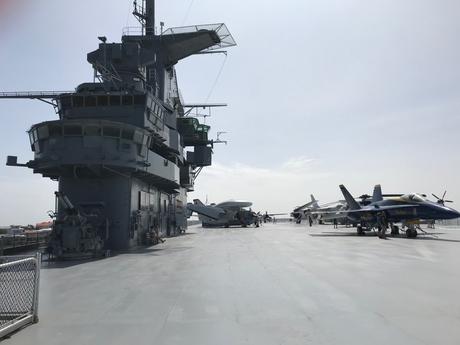On the final day of our Charleston odyssey we toured the USS Yorktown, an aircraft carrier dry-docked at Point Pleasant. One of my uncles served on the Yorktown between the Korean and Vietnam wars and was able to show us around. What really struck me, as often does with military matters, is just how advanced our engineering is when it comes to war. The aircraft carrier was invented to meet a belligerent need: to convey aircraft close enough to other nations to support air strikes against “targets” there. These targets consist of living, breathing human beings, at least in part. But the technical problems, where I’d rather focus this post, were formidable. How do you land a plane moving at 200 miles per hour on a moving ship with limited runway? And how do you do it without tearing the plane apart from the sudden deceleration?

Carriers have steel cables stretched across the landing strip. A tail hook on the plane, or later jet, would catch a cable, wound several times below deck to increase the ratio of force (as with a pulley), to add enough play to stop a plane without the forward motion tearing it apart. Five cables stretched across the deck and the ideal was to catch the third one for an optimal landing. Each landing (which could take place 30 seconds apart) was filmed and analyzed for improvements. Listening to the technical nature of all this, and knowing that such things had been invented some eighty years ago, made me wonder, yet again, at how creative human beings are. And made me ponder why so much of our creativity goes toward war machines. Just think of the problems we could solve if we all worked together! Instead, Putin covets Ukraine, Trump covets everything, and we fall in line behind them.
I’ve written on such topics before. I took a self-tour of the USS Midway while in San Diego as part of a business trip back in 2014. The tech there was perhaps a bit more advanced as this was a nuclear carrier. Standing on this deck, however, thinking how this one ship costs more than I will earn with a lifetime of education and employment, leaves me a bit reflective. Those who push for wars are often those on their knees praying for the second coming. The rest of us, content with the first coming, think how the message of love and peace seems to have been swallowed by a whale. But this ship is larger than any whale, and, I’m told, much, much more expensive.
